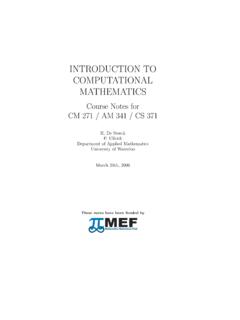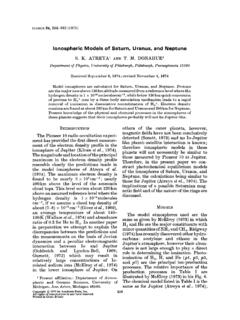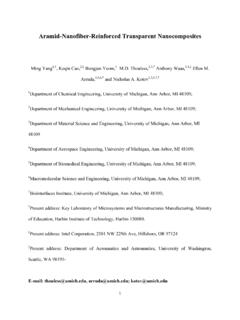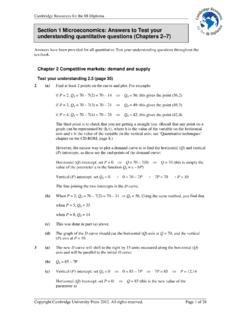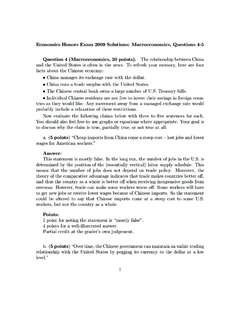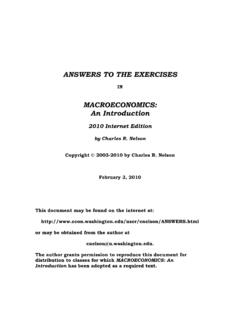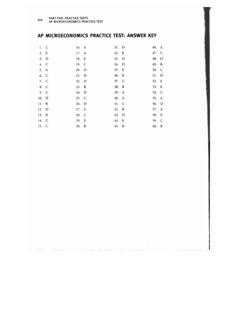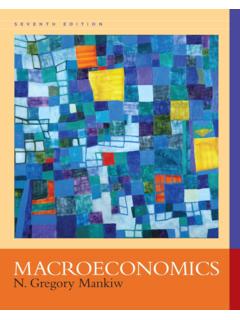Transcription of Study Questions (with Answers) - www-personal.umich.edu
1 Econ 340 Alan Deardorff Fall Term 2019 Int Macro Study Questions ( with answers ) Page 1 of 5 Study Questions ( with answers ) Lecture 15 International macroeconomics Part 1: Multiple Choice Select the best answer of those given. 1. If the aggregate supply and demand curves in the figure at the right describe the situation in an economy at some point in time, we would expect to see a. Output at " at that time. b. Prices rising over time. c. The price level at " at that time. d. More unemployment than normal. e. GDP at its long run level. Ans: b 2. When a country devalues its currency, we expect that a. Income will rise because the devaluation stimulates aggregate demand. b. Income will rise because the devaluation stimulates aggregate supply. c. Income will fall because the devaluation reduces aggregate demand. d. Income will fall because the devaluation reduces aggregate supply.
2 E. There will be no change in income because income is earned from production, not from trade. Ans: a ADYPSRASP2 LRASP1P3Y2Y1 Econ 340 Alan Deardorff Fall Term 2019 Int Macro Study Questions ( with answers ) Page 2 of 5 3. with a floating exchange rate, a monetary contraction causes a. The exchange rate to depreciate. b. The interest rate to fall. c. National income to increase d. A capital inflow. e. The price level to rise. Ans: d 4. Suppose that a country has a mixture of individuals and companies that are in each of the following situations: Group I. These have borrowed in domestic currency to finance assets whose values are also in domestic currency. Group II. These have borrowed in foreign currency to finance assets valued in domestic currency. Group III. These have borrowed in domestic currency to finance assets valued in foreign currency.
3 Group IV. These have borrowed in foreign currency to finance assets valued in (the same) foreign currency. Which of these groups see the domestic-currency value of their wealth fall when the country devalues? (Assume in each case that the initial value of the assets is at least as great as what was borrowed.) a. I only. b. II only. c. III only. d. IV only. e. II and IV only. Ans: b 5. If the economy moves into recession due to a decline in consumer confidence, which of the following do we not expect? a. The dollar will depreciate. b. The interest rate will fall. c. GDP in other countries will expand. d. Aggregate demand abroad will decline. e. imports will shrink. Ans: c Econ 340 Alan Deardorff Fall Term 2019 Int Macro Study Questions ( with answers ) Page 3 of 5 6. According to the estimates of pass-through in the assigned reading by Mann and Pl ck, if a foreign currency appreciated against the US dollar by 25%, by how much would you expect the prices of imports from that country to rise, within the US, after several quarters?
4 A. Not at all b. 4% c. 10% d. 25% e. 40% Ans: c (The article reports an estimate of 4% rise for a 10% dollar depreciation, so that scales up to a 10% rise for a 25% depreciation.) 7. Which country does the Economist article More Spend, Less Thrift criticize, and why? a. Germany, because its budget surplus and current account surplus reduce demand for other countries goods. b. Italy, because its budget deficit and current account deficit are putting it further into debt. c. Spain, because its budget deficit and current account surplus are inconsistent and create tensions in the world economy. d. France, because its budget deficit and current account deficit cause it to buy excessive amounts of goods from Germany and other EU countries. e. The United States, because its military spending is creating the danger of a third world war.
5 Ans: a Econ 340 Alan Deardorff Fall Term 2019 Int Macro Study Questions ( with answers ) Page 4 of 5 Part II: Short Answer Answer in the space provided. 1. The graph below shows the foreign exchange market from the perspective of the Japanese economy, with the dollar as its foreign currency. Suppose that a decline in investor expectations within Japan now causes aggregate demand there to fall, reducing output and prices. a. Show the effects of this change on supply and demand for foreign exchange (dollars) in the figure, and explain the reasons for these changes. The decline in Japanese income and prices will reduce their demand for imports, thus also reducing their demand for dollars and shifting the D$ curve to the left. The decline in income also causes a fall in the Japanese interest rate, causing a net capital outflow.
6 The outflow can be viewed as increasing the demand for dollars, reducing the supply, or both, and should be expected to be a larger effect than the change in trade. Therefore, most simply we could capture all of this with a rightward shift of the D$ curve (or, if you prefer, a leftward shift in D$ and a larger leftward shift of S$-- the answers below will be the same either way). b. Had the Japanese exchange rate relative to the dollar been floating, how would this contraction of the Japanese economy altered the value of its currency? It would depreciate the yen. (The equilibrium yen/dollar rate shown in the figure goes up, which is a fall in the value of the yen.) c. Suppose instead, though, that the Japanese central bank was pegging the yen to the dollar at the exchange rate shown as in the figure. Use the figure to E Econ 340 Alan Deardorff Fall Term 2019 Int Macro Study Questions ( with answers ) Page 5 of 5 determine first the nature of the intervention that would be required to maintain that peg, and second how that intervention will change as a result of the shifts in curves that you found in part (a).
7 At the initial positions of the curves in the figure, there is excess demand for dollars at . Thus the central bank must sell dollars out of its reserves. The shifts in curves found in part (a) cause the size of this excess demand to increase, so the central bank must give up its reserves even faster. 2. Suppose that a company in India initially owns a factory worth 45 million rupees, that it has borrowed 1 million US dollars to finance its construction, and that these are its only assets and liabilities. a. If the exchange rate is initially 40 rupees per dollar, what is the initial value of the company, in rupees? Ans: 5 million rupees. b. If the rupee now depreciates by 20% what does the value of the company in rupees become? Ans: Negative 3 million rupees. (The exchange rate depreciates 20% from 40 to 48 rupees/$.) c. Would the effect of the depreciation on the value of the company be any different if it was measured in dollars?
8 Ans: Not really; it is still negative. In dollars, the value of the company goes from +$125,000 (=45,000,000/40 1,000,000=1,125,000 1,000,000) to -$62,500 (=45,000,000/48 1,000,000=937,500 1,000,000). 3. In class you saw a graph of the exchange value of the US dollar relative to five other currencies, since the beginning of this century. Relative to the currency of each country, indicate whether the dollar has appreciated or depreciated from 2002 to 2017. Relative to The US dollar [appreciated or depreciated] Canada Depreciated China Depreciated Euro Depreciated Japan Depreciated Mexico Appreciated E





